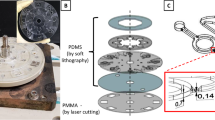Abstract
In this article, we demonstrate a novel approach to implementing multiplex enzyme-linked immunosorbent assay (ELISA) in a single microfluidic channel by exploiting the slow diffusion of the soluble enzyme reaction product across the different assay segments. The functionality of the reported device is realized by creating an array of ELISA regions within a straight conduit that are selectively patterned with chosen antibodies/antigens via a flow-based method. The different analytes are then captured in their respective assay segments by incubating a 5-μL aliquot of sample in the analysis channel for an hour under flow conditions. Once the ELISA surfaces have been prepared and the enzyme substrate introduced into the analysis channel, it is observed that the concentration of the soluble enzyme reaction product (resorufin) at the center of each assay region grows linearly with time. Further, the rate of resorufin generation at these locations is found to be proportional to the concentration of the analyte being assayed in that segment provided that the ELISA reaction time in the system (τ R ) is kept much shorter than that required by the resorufin molecules to diffuse across an assay segment (τ D ). Under the operating condition τ R << τ D , the reported device has been shown to have a 35% lower limit of detection for the target analyte concentration compared with that on a commercial microtiter plate using only a twentieth of the sample volume.






Similar content being viewed by others
References
Kemeny DM, Challacombe SJ (1988) ELISA and other solid phase immunoassays: theoretical and practical aspects. Wiley, New York
Nemzek JA, Siddiqui J, Remick DG (2001) Development and optimization of cytokine ELISAs using commercial antibody pairs. J Immunol Methods 255:149–157
Ling MM, Ricks C, Lea P (2007) Multiplexing molecular diagnostics and immunoassays using emerging microarray technologies. Expert Rev Mol Diagn 7:87–98
Hayes D (2009) Saving time and sample. Drug Discovery Dev 12:22–25
Herrmann M, Veres T, Tabrizian M (2008) Quantification of low-picomolar concentrations of TNF-alpha in serum using the dual-network microfluidic ELISA platform. Anal Chem 80:5160–5167
Ng AHC, Uddayasankar U, Wheeler AR (2010) Immunoassays in microfluidic systems. Anal Bioanal Chem 397:991–1007
Cheow LF, Ko SH, Kim SJ, Kang KH, Han J (2010) Increasing the sensitivity of enzyme-linked immunosorbent assay using multiplexed electrokinetic concentrator. Anal Chem 82:3383–3388
Osuchowski MF, Remick DG (2006) The repetitive use of samples to measure multiple cytokines: the sequential ELISA. Methods 38:304–311
Nielsen UB, Geierstanger BH (2004) Multiplexed sandwich assays in microarray format. J Immunol Methods 290:107–120
Ross JS, Hatzis C, Symmans WF, Pusztai L, Hortobagyi GN (2008) Commercialized multigene predictors of clinical outcome for breast cancer. Oncologist 13:477–493
Yang LN, Guo SJ, Li Y, Zhou SM, Tao SC (2011) Protein microarrays for systems biology. Acta Bioch Bioph Sin 43:161–171
Niotis AE, Mastichiadis C, Petrou PS, Christofidis I, Kakabakos SE, Siafaka-Kapadai A, Misiakos K (2010) Dual-cardiac marker capillary waveguide fluoroimmunosensor based on tyramide signal amplification. Anal Bioanal Chem 396:1187–1196
The handbook—a guide to fluorescent probes and labeling technologies, 10th edn: Invitrogen, web edition. Available at: http://probes.invitrogen.com/handbook/sections/0602.html, Section 6.2: Tyramide Signal Amplification Technology
Ohno K, Tachikawa K, Manz A (2008) Microfluidics: applications for analytical purposes in chemistry and biochemistry. Electrophoresis 29:4443–4453
Mecham JO, Wilson WC (2004) Antigen capture competitive enzyme-linked immunosorbent assays using baculovirus-expressed antigens for diagnosis of bluetongue virus and epizootic hemorrhagic disease virus. J Clin Microbiol 42:518–523
Mecham JO, Jochim MM (2000) Development of an enzyme-linked immunosorbent assay for the detection of antibody to epizootic hemorrhagic disease of deer virus. J Vet Diagn Invest 12:142–145
Mecham JO (2006) Detection and titration of bluetongue virus in Culicoides insect cell culture by an antigen-capture enzyme-linked immunosorbent assay. J Virol Methods 135:269–271
Reyes DR, Iossifidis D, Auroux PA, Manz A (2002) Micro total analysis systems. 1. Introduction, theory, and technology. Anal Chem 74:2623–2636
Szekely L, Guttman A (2005) New advances in microchip fabrication for electrochromatography. Electrophoresis 26:4590–4594
Hanly WC, Artwohl JE, Bennet BT (1995) Review of polyclonal antibody production procedures in mammals and poultry. ILAR J 37:93–118
Lesley SA, Groskreutz DJ (1997) Simple affinity purification of antibodies using in vivo biotinylation of a fusion protein. J Immunol Methods 207:147–155
Mecham JO, Dean VC, Wigington JG, Nunamaker RA (1990) Detection of bluetongue virus in Culicoides variipennis (Diptera: Ceratopogonidae) by an antigen capture enzyme-linked immunosorbent assay. J Med Entomol 27:602–606
Gorris HH, Walt DR (2009) Mechanistic aspects of horseradish peroxidase elucidated through single-molecule studies. J Am Chem Soc 131:6277–6282
Cussler EL (2009) Diffusion: mass transfer in fluid systems. Cambridge University Press, Cambridge
Schilling EA, Kamholz AE, Yager P (2002) Cell lysis and protein extraction in a microfluidic device with detection by a fluoregenic enzyme assay. Anal Chem 74:1798–1804
Tsang VCW, Wilson BC, Peralta JM (1983) Quantitative, single-tube, kinetic-dependent enzyme-linked immunosorbent assay. Method Enzymol 92:391–403
Lim CT, Zhang Y (2007) Bead-based microfluidic immunoassays: the next generation. Biosens Bioelectron 22:1197–1204
Rissin DM et al (2010) Single-molecule enzyme-linked immunosorbent assay detects proteins at sub-femtomolar concentrations. Nat Biotechnol 28:595–599
Acknowledgments
This research work was supported by start-up funds from the University of Wyoming and a grant from the National Science Foundation (DBI 0964211). N.Y. also acknowledges graduate assistantship through the Wyoming INBRE program (grant # P20RR016474).
Author information
Authors and Affiliations
Corresponding author
Electronic supplementary materials
Below is the link to the electronic supplementary material.
ESM 1
(PDF 96.5 kb)
Rights and permissions
About this article
Cite this article
Yanagisawa, N., Mecham, J.O., Corcoran, R.C. et al. Multiplex ELISA in a single microfluidic channel. Anal Bioanal Chem 401, 1173–1181 (2011). https://doi.org/10.1007/s00216-011-5191-0
Received:
Revised:
Accepted:
Published:
Issue Date:
DOI: https://doi.org/10.1007/s00216-011-5191-0




